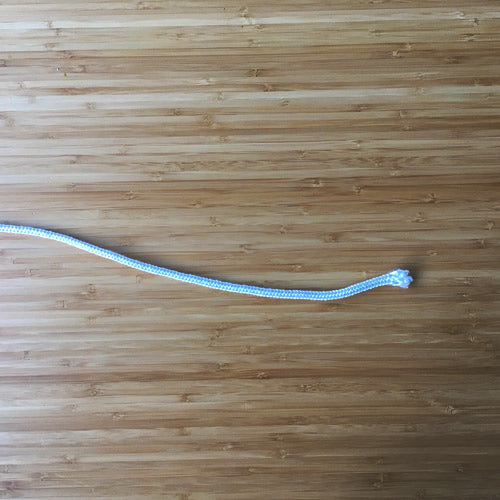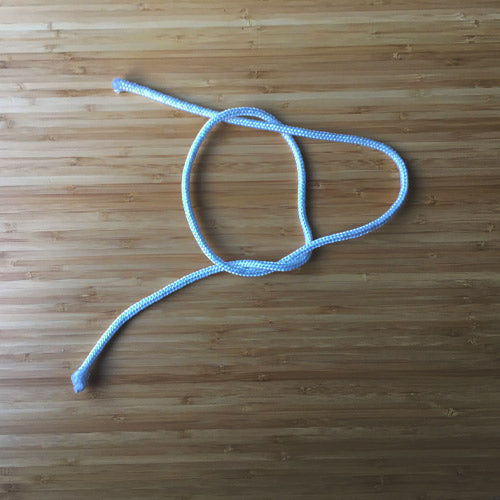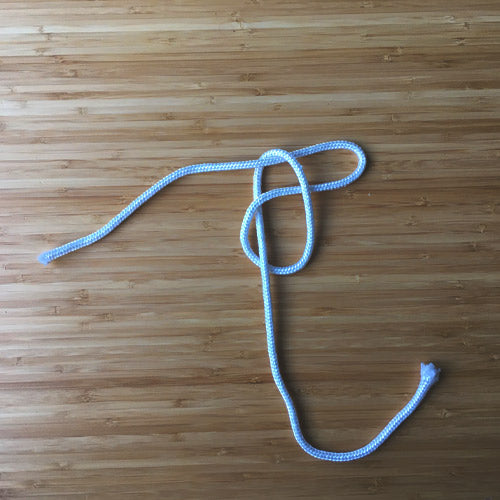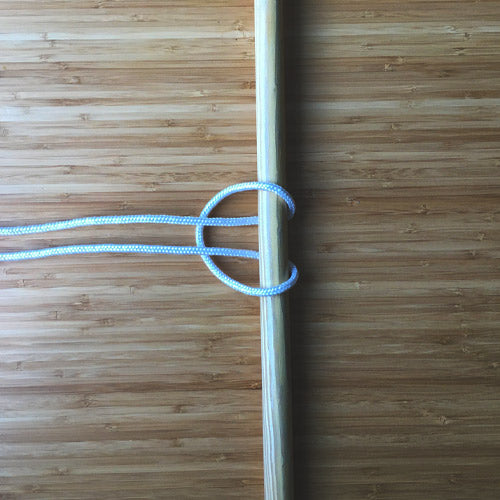This tutorial will show you how to tie knots that will suit most—if not all—of your outdoor needs. In fact, these are the very knots that rock-climbers, backpackers and hunters rely on when they're out in the wild. We’ll be sharing plenty of pictures to reference. We'll also be digging into what each knot is best used for along with how (and why) it works.
And, if you're new at the art of knot tying, don't worry. We've got a handful of basic knots to help you get started. If some terms get too technical, check out the glossary located at the end of the post.
11 Common and Useful Knots
If you were to only learn a handful of knots that would serve you in all kinds of situations in the outdoors, here are the ones we'd recommend:

1. Square knot
Knot type: A popular and easy binding knot also called a ‘joining’ or ‘reef knot.’
Why use it: One of the most popular and well-known knots, this is best used when you need to join two pieces of rope together, or when you want to secure the rope to an object. Keep in mind that the two ropes need to be the same size diameter in order for the knot to work and not slip. This can be useful for carrying, moving stacks of firewood or for binding bandages.
Common activities: Hiking, Boating, Sailing, First Aide
Considerations: This knot is created by two overhands knots. It’s not reliable in lifting heavy loads.
2. Clove hitch
Knot type: Hitch, binding knot.
Why use it: Because of the clove hitches versatility it is one of the most important knots you can know how to make. It’s composed of two half hitches that join which creates one clove hitch. You can make as many half hitches as you want on an object. This kind of knot ties in the middle of a piece of rope and can begin or complete lashings. It’s easy to make and can secure a rope to an object such as a tree or pole. It can handle a lot of weight and works well in hoisting heaving objects. If you get enough practice at making a clove hitch, you’ll find you can learn to tie it one-handed.
Common activities: Hiking, Sailing, Boating, Rock climbing, lifting heavy objects
Considerations: There’s over one way to tie this knot. An easy way is by looping the rope counter-clockwise across an object and creating a crossing point. Then make another counter-clockwise loop and feed the end of the rope through the loop. Tighten by pulling both ends.
Warning: The knot can slip and come undone if pressures removed from the line.
3. Bowline
Knot type: Loop
Why use it: This quick and easy knot creates a fixed loop at the end of your rope that works alone or as the beginning stages to creating a slip knot. The knot strengthens when weight is applied to it and it has many outdoor uses. It can secure a line on a boat to a post, tie hammocks, suspend bear bags, secure climbers to their harness, and it may also get tied around rescuers waists during rescue operations. The knot is very easy to tie and untie, even after it's been used to lift heavy items.
Common activities: Hiking, Sailing, Boating, Rock climbing, Rescue operations
Considerations: To tie make a loop on the standing side, slide the end of the rope through the loop like if making an overhand knot. Then go around the standing end and up through the loop. Tighten by pulling the standing side while holding the bight.
4. Figure Eight
Knot type: Loop, Stopper
Why use it: You can use the same figure-eight method used in creating this knot to make either a knot or a loop that gets placed at the end of a line. This is one of the strongest on our list and it doesn’t easily slide. It can come in handy when you need to make a secure loop in the middle of your rope or for attaching a lure or rig to a fishing line. It’s also often used by rock climbers when attaching a rope to their climbing harness, and since its shape is so recognizable it's easy to double-check for safety reasons. The downfall to this knot is that it's tough to get undone, especially after there’s been some serious weight applied to it.
Common activities: Rock climbing, Caving, Sailing, Fishing, Outdoor use
Considerations: A common stopper knot, the figure-eight is made by forming a loop, twisting it once, feeding the tail through the upper loop and then pulling at both ends.
5. Half hitch
Knot type: Hitch
Why use it: The half hitch is a basic overhand knot that’s more of a support knot compared to the others on our list. It’s not very secure on its own, so it’s rarely used alone but becomes an accompaniment to strengthen others (like the two half hitch we’re about to mention below.) It can be used for temporarily tying two light objects together or even for hanging small amounts of food to keep out of the way of mice… Which might just come in handy during a few overnight shelter stays.
Common activities: Support knot, hanging small objects.
Considerations: Bring the working end of the rope over then under the standing end to create this straightforward overhand knot.
6. Two half hitch
Knot type: Hitch
Why use it: As the name suggests, the two-half hitch combines two of the half hitch knots together. The tighter you pull on the rope, the more the rope will tighten around the object. It’s a much more secure knot than its half-version and it’s used to tie and cinch down one object to another sturdier, fixed object (post, tree). Because it’s a sliding knot, it’s also very easy to loosen. This is useful in tying tarp lines, hanging clotheslines or hammocks, tying equipment down to the top of your vehicle or mooring a boat to a pole. Be sure to use this knot when tensions applied to the line, as it can come loose if there’s too much slack.
Common activities: Hiking, Guy lines for Tarps, Tent set-up, attaching items to backpack, Sailing, Boating, Weaving, Fishing
Considerations: Made by joining two half hitches together, be sure that the half hitches both go in the same direction.
7. Taut-line hitch
Knot type: Loop
Why use it: This knot creates an adjustable loop that can easily slide up and down a rope to tighten or loosen the tension of the rope. Under tension, the knot will lock into place so it won’t slip. Creating a taut-line hitch can serve many uses around camp, including tying items to the outside of your pack, securing tent-guy lines, helping to install a tarp or a rain fly to use overtop of your hammock, and even for hanging a bear bag. This knots definitely a reliable one, it’s even been used by astronauts in space during repair missions.
Common activities: Hiking, Tree climbing, Sailing, securing heavy loads on vehicles
Considerations: Wrap the rope around a sturdy object, take the working end under the standing end and wrap it around twice, add a half hitch and bring the working end back over the standing end. Tighten it enough to be secure, but not enough so it can’t slide.
8. Marlin-spike toggle
Knot type: Hitch
Why use it: You could create this knot if you wanted to place a wood handle on a rope while making a rope ladder. Or if you were looking for a way to secure a solid object to the rope so you could use that object to grab onto for better grip than just pulling with your bare hands. This would help to prevent injury and give you more overall control. Hammock campers also use this knot often with a toggle for hanging hammocks and attaching whoopie slings to a tree strap.
Common activities: Hiking, Hammock set-up, Sailing, Boating
Considerations: The “handle” you create on this knot could be made from branches, a pole, or even a small pocketknife. The knot is made by crossing the standing end over working for a loop, flip the loop upwards, push the bight of the standing end through the loop then pull both ends tight.
9. Trucker’s Hitch
Knot type: Hitch, Cinch knot
Why use it: This knot is best used for heavier objects and loads. It works in tying down long lines of rope and can be handy when you want to strap and secure something down to a vehicle or trailer. You can also use this knot for creating clotheslines, tying down sails, securing the guy lines on your tent or tarp with tension, or if you need to fasten down the ropes on your boat, kayak or canoe.
Common activities: Strapping down heavy objects, Camping, Sailing, Boating
Considerations: This knot is very strong and is made from three different parts that when tightened has a 3-to-1 power-driven advantage.
10. Prusik knot
Knot type: Hitch, Friction knot
Why use it: Made from a smaller cord attaching to a larger rope, the Prusik knot is also called a “friction hitch.” This knot creates a loop that can move up or down a line. It's used when you want to loop around an object, but still want to have that loop be able to slide vertically along the rope when the tension gets released. As soon as tension is applied, the knot and loop will lock into place. This is a common knot among mountaineers and climbers when they need to create loops they can use to ascent vertically, or if they require the use of both of their hands while climbing.
Common activities: Mountaineering, Climbing, Caving, Rescue, Rappelling
Considerations: Rope size is important in making this knot, and a general rule of thumb is that the Prusik knot cord should be smaller in diameter than the rope that you are attaching too.
11. Lark’s head
Knot type: Hitch, Loop
Why use it: Very similar to the square knot, the Lark’s head is often also referred to as a “cow hitch.” It’s a very common, straightforward and easy to tie choking loop that is useful when you need to quickly create a loop in the middle of your line that will secure a rope to an object. Likewise, it works if you need to connect two lines together. There’s also a version of this called the “double larks-head” which is essentially just two lark head knots together. This version will help secure the knot to stay in the center of an object if that is a concern. This knot can also be used to temporarily tighten and seal off the top of a bag while still allowing you easy access to get in and out of the bag if need be. Another good use is looping it around a dog’s collar to use as a leash.
Common activities: Hiking, Mountaineering, Climbing, Rescue, Sailing, Boating, Securing Livestock to a post
Considerations: The knot requires applied tension in order for it to pull tight.





















































































































